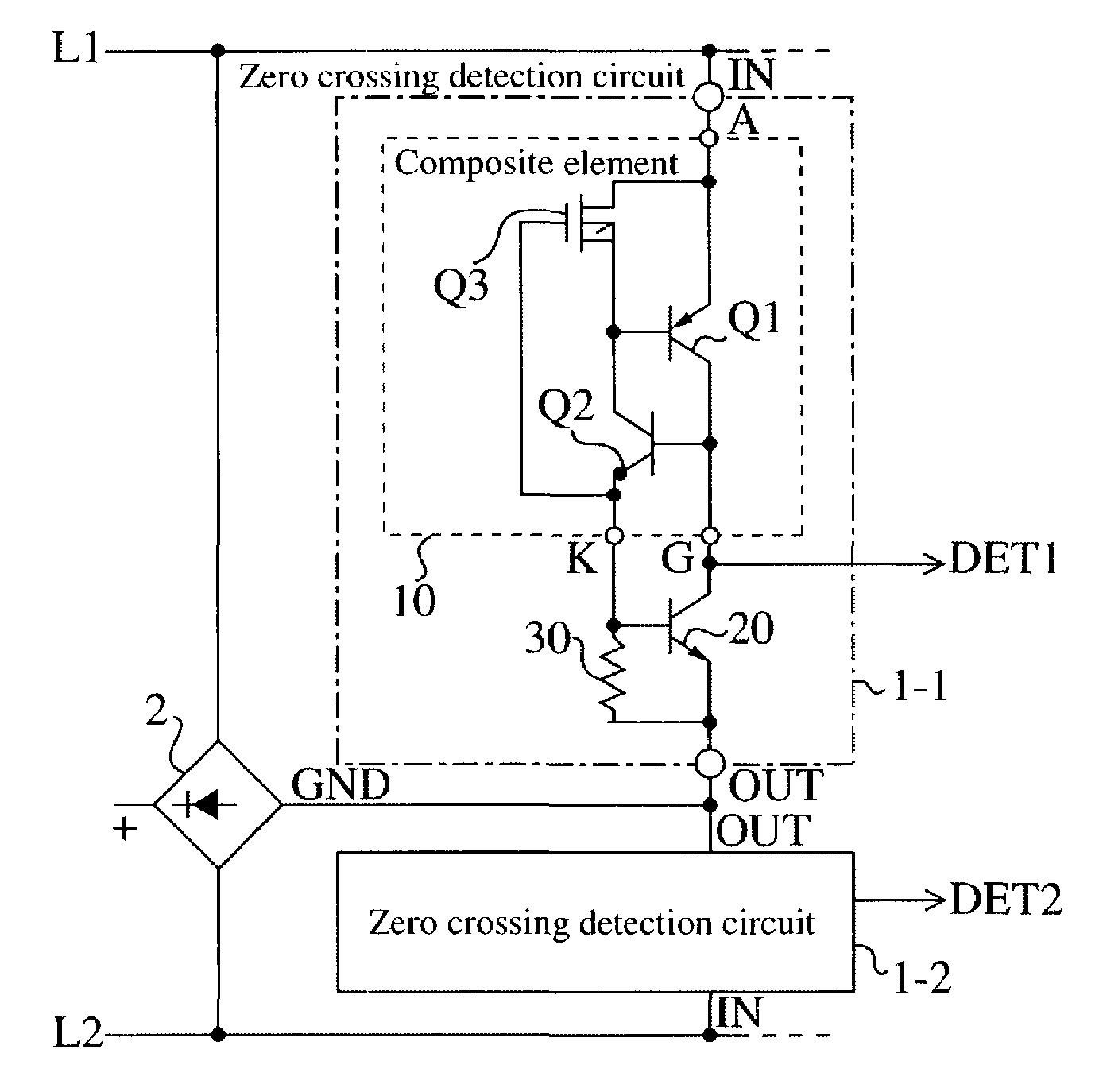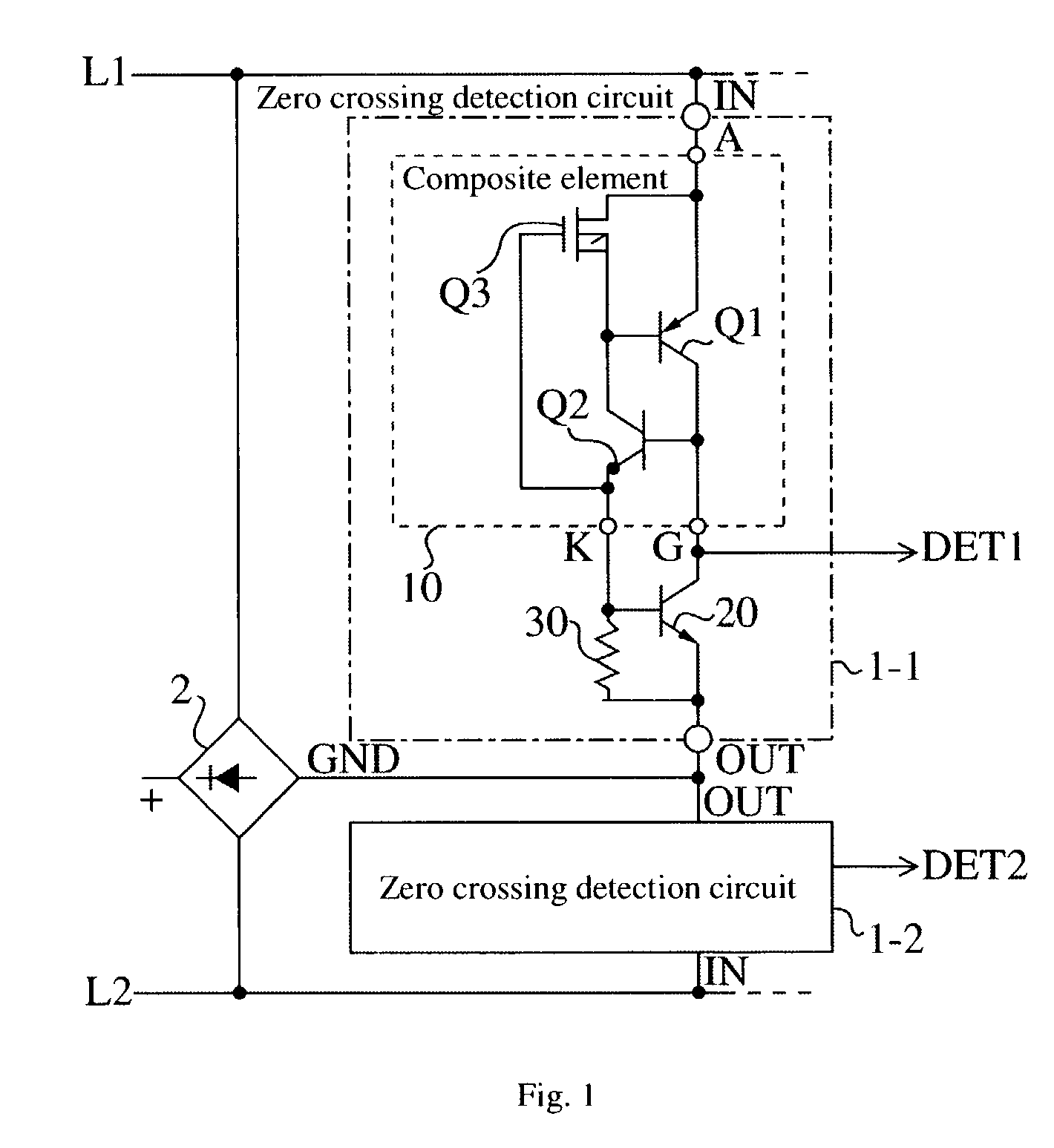Zero crossing detection circuit
a detection circuit and zero-passing technology, applied in the field of zero-passing detection circuits, can solve the problems of large integrated circuit size and inability to integrate in an integrated circuit, and achieve the effects of high withstand voltage, convergence of applied voltage into an electric field, and reduced size of integrated circuits
- Summary
- Abstract
- Description
- Claims
- Application Information
AI Technical Summary
Benefits of technology
Problems solved by technology
Method used
Image
Examples
first embodiment
[0043]FIG. 1 is a circuit diagram of a polarity reversal detection circuit of the present invention.
[0044]This polarity reversal detection circuit is for, in a non-ringing terminal such as a telemeter, detecting polarity reversal information, being a seize signal or a restore signal, transmitted from a telephone, and comprises a full wave rectifier circuit 2 connected across telephone lines L1 and L2, and zero crossing detection circuits 1-1 and 1-2 respectively connected across the telephone lines L1 and L2 and a negative electrode GND side of the full wave rectifier circuit 2.
[0045]The zero crossing detection circuits 1-1 and 1-2 have the same structure, and the zero crossing circuit 1-1, for example, is comprised of a 3-terminal composite element 10 having a combination of thyristors and MOS transistors, an NPN fixed current transistor 20 and a resistor 30, and has an input terminal IN connected to a telephone line side, and an output terminal OUT connected to a ground potential ...
second embodiment
[0072]FIG. 5(a) to FIG. 5(c) are schematic diagrams of a zero crossing detection circuit of the present invention. Elements that are the same as those in FIG. 1 will be assigned the same reference numerals.
[0073]The zero crossing detection circuit of FIG. 5(a) has a voltage breakdown element (for example a Zener diode) 40 inserted between the input terminal IN and the anode terminal A of the composite element 10. The zero crossing detection circuit of FIG. 5(b) has a Zener diode 40 inserted between the emitter of the transistor 20 and the output terminal OUT. The zero crossing detection circuit of FIG. 5(c) has a Zener diode 40 inserted between the cathode terminal K of the composite element 10 and the base of the transistor 20. The remaining structure is the same as the zero crossing circuit in FIG. 1.
[0074]With this type of structure, when the potential of the input terminal IN rises with respect to the potential of the output terminal OUT, current will not flow until the breakdow...
third embodiment
[0076]FIG. 6(a) to FIG. 6(c) are schematic diagrams of a zero crossing detection circuit of the present invention, and elements that are the same as those in FIG. 1 will be assigned the same reference numerals. The zero crossing detection circuit of FIG. 6(a) has an output circuit (for example, a current mirror) 50 inserted between the input terminal IN and the anode terminal A of the composite element 10. The current mirror 50 comprises resistors 51 and 52, and PNP transistors 53 and 54, with one end of each resistor 51 and 52 being connected to the input terminal IN. The other end of resistor 51 is connected to the emitter of transistor 53, while the collector and base of the transistor 53 are connected to the anode terminal A of the composite element 10. The other end of the resistor 52 is connected to the emitter of transistor 54, and the base of transistor 54 is connected to the anode terminal A of the composite element 10. A detection current DETo is then taken out from the co...
PUM
 Login to View More
Login to View More Abstract
Description
Claims
Application Information
 Login to View More
Login to View More - R&D
- Intellectual Property
- Life Sciences
- Materials
- Tech Scout
- Unparalleled Data Quality
- Higher Quality Content
- 60% Fewer Hallucinations
Browse by: Latest US Patents, China's latest patents, Technical Efficacy Thesaurus, Application Domain, Technology Topic, Popular Technical Reports.
© 2025 PatSnap. All rights reserved.Legal|Privacy policy|Modern Slavery Act Transparency Statement|Sitemap|About US| Contact US: help@patsnap.com



